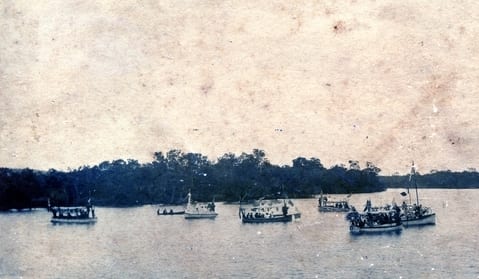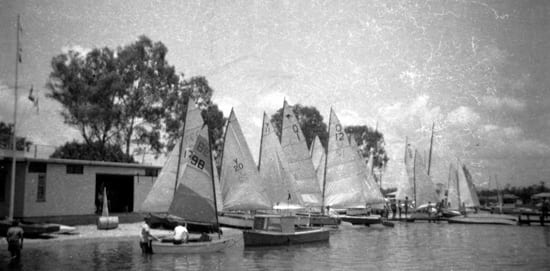Celebratory and sporting events have been held on the Noosa River and on Lake Cootharaba since the 1870s.

Aquatic sports on the Noosa River, New Year’s Day 1949. Image courtesy of Sunshine Coast Libraries
Navigating the Noosa River, and particularly the sand bar at the mouth between the north and south heads, was difficult from the outset. The value of the timber industry in Noosa prompted the colonial Queensland Government to survey the river in 1869, to ensure safe passage for both passengers and cargo. The mapping of ‘Nusa Harbour’ was completed by Port Master of Queensland, George Heath, in the tug, Brisbane. He recorded high tide depths of 7 feet (more than 2 metres) over the bar and 9-12 feet (approaching 4 metres) in the lower river. He noted the mouth of ‘Weba Creek’, several wooded islands, and marked a series of shifting sand banks. He also reported that the Noosa River was a better outlet for timber than either the Mary River or the Maroochy River. Further surveying of the river in 1876 was completed in great detail by Staff Commander E.P. Bedwell. He took soundings up to 21 feet (6.4 metres) using a marked pole and a lead line. Bedwell reported that the bar at the mouth of the river and the sand heads were constantly changing and that the whole estuary was a maze of sand banks.
The new town of Tewantin began to grow in the 1870s as the established port on the river. Ships became more regular and frequent such as the steamer, Culgoa, which made innumerable trips between Tewantin and Brisbane before eventually being wrecked on the Noosa River bar in 1891. The 1890s would then see a dramatic decline in the number of large vessels on the Noosa River due to completion of the railway from Brisbane to Gympie (and thus much less reliance on the port of Tewantin) and due to economic recession, which exacerbated the decline in the timber industry.
Meanwhile the handful of residents along the area of the riverbank becoming known as Gympie Terrace slowly increased. Separated from Tewantin by water, they each had their own boat for transport and fishing. Until the 1920s these were mostly rowboats and sailboats. One early vessel with an internal combustion engine was the Weyba built locally in the 1890s with a Wilson engine. Another was Jannet, owned by Colonel Reid, who moved to Gympie Terrace around 1902. Motorboats remained rare until after the First World War (1914-1918).

Joe Keyser on the shore of Lake Weyba, circa 1910
Professional fishing had begun back in the 1870s with Joe Keyser delivering fish to the booming mine town of Gympie by wheelbarrow. Other Gympie Terrace residents mostly fished for their own consumption. But, having grown up on the river, the next generation produced more fishermen. Both Ned Ely and Alex Gibson had their own fishing boats. They were soon joined by the Massoud family, who set up a shop and later a café on Gympie Terrace. The construction of an ice house in Tewantin would soon allow much greater opportunity for making a living from the fish in the river.
At this time, if you did not have your own boat, the only real access to Gympie Terrace was aboard Jack Tedford’s ferry, The Emerald. In 1915, Jiddy Massoud bought Riverlight. The boat increased his capacity for fishing but it was also used to deliver mail three times a week to Gympie Terrace and Noosa Heads. He also secured a contract with the Education Department to transport the children to school in Tewantin. At the age of just 12, his son George became the skipper responsible for the student transport.

Peace flotilla on the Noosa River, July 1919. Image courtesy of Olive Donaldson
When the offfical peace treaty ending the First World War with Germany was signed at Versailles in France in July 1919, the shire of Noosa celebrated along with the rest of the nation, including a ‘peace flotilla’ on the Noosa River. A number of boats dressed up in the national dress and flew the flags of the victorious allied nations. From Gympie Terrace, Alexander Gibson’s boat represented Belgium and Frederick Kearton’s boat represented Serbia.

Jack, Howard & Daisy Parkyn on Miss Tewantin, late 1920s

Miss Tewantin, 1950s
The first major transport boat at Gympie Terrace was the Miss Tewantin, a 60-passenger launch. It was originally built for the Tewantin hotelier Varce Cardell in 1923 by the Brisbane ship builder Norman Wright (who also built Riverlight). In 1925, it was bought by Jack Parkyn who had returned to Munna Point after years in Gympie with his wife, Daisy. At first Miss Tewantin was primarily engaged with transporting people from Tewantin to Noosa Heads. But Jack and Daisy’s eldest son, Howard, would sometimes accompany Captain Arthur Halliday in the boat with loads of fish to Brisbane, bringing back supplies for the family store. The trip would take at least eight hours, so they would have to leave Brisbane early in order to reach Noosa in daylight to cross the dangerous bar at the mouth of the river (and possibly to load extra cargo and dodge the boating Inspectors). Miss Tewantin was also used for tourist trips to the lakes and to the coloured sands via the river and Teewah landing.
In 1929 the Doonella Bridge and the Weyba Bridge were completed providing easy access to Gympie Terrace and Noosa Heads by road. Cars were becoming cheaper and more common but many locals continued to travel locally by boat for a long time.
The continued increase in tourists during in the 1930s saw an increase in boat tours, provided by the Parkyn and Massoud families amongst others. Renting one of Jack Parkyn’s holiday cottages in Russell Street included the provision of a small boat.
Terrace Boat Hire, one of the first boat hire businesses on the river, was begun by Tom and Audrey Salta in 1938, opposite their grocery shop, Terrace Stores, on the corner of Gympie Terrace and Weyba Road. The successful business continued under their son, George, and his wife Jean, and remains operational as T Boat Hire today.

Unloading a fishing boat at a jetty on Gympie Terrace, 1930s
Fishing continued to grow in the area as well, both with amateurs and professionally. But professional fishing expanded quickly after World War II (1939-1945) and brought lots more boats and trawlers to the Noosa river in the late 1940s and 1950s.
After Len Ely returned from the war, he and his wife, Betty, set up the business O Boat Hire with a fleet of small vessels. The initial price was 25 shillings a week (about $350 today). Len eventually sold the business in 1974 but O Boat Hire continues today, as do numerous others along the bank of Gympie Terrace.
Celebrations, sailing contests and other water sport competitions had been held on Lake Cootharaba and the Noosa River since the 1870s but became a regular feature of the river communities in the middle of the 20th Century. On New Year’s Day in 1949 an aquatic sports day on the river in front of Gympie Terrace was well attended. In 1952 a power boat competition was held on New Year’s Day and this soon became a regular event. By the early 1960s this had grown into the Festival of the Waters, celebrated annually until the mid 1980s.

Aquatic Sports Day, New Year’s Day 1949. Image courtesy of Sunshine Coast Libraries

Powerboat competition, New Year’s Day 1952. Image courtesy of The Courier Mail

Powerboat competition, New Year’s Day 1972
The Parkyn family eventually had Miss Tewantin II built by local shipwright, James McKenna, to help ferry tourists on the river. Their fleet grew up to around 30 boats for hire, as well as the prawn catching Victory. In 1965, the Duke and Duchess of Gloucester travelled aboard the Miss Tewantin during their visit to Noosa. The following year the Parkyn brothers sold their boats. But Miss Tewantin was still in service until 1983 on the Hawkesbury River in New South Wales before being renamed The Pelican and beginning work at Port Macquarie.

Launching Harry Davis’ boat from Gympie Terrace, circa 1955
An official Noosa Yacht Club was established in 1958 on Gympie Terrace. A clubhouse was built in 1961. The Noosa Rowing Club was formed in 1981 and the two were joined together in 1984, moving to their new premises at the mouth of the Noosa Waters canal in 1994.

Noosa Yacht Club, early 1980s
A cruising restaurant, Laguna Belle, began sailing the Noosa River in 1976. The double-decker boat was designed to look like a paddle steamer. Despite its shallow draught, its owner and skipper, Fred Cooper, was affectionately nicknamed ‘Captain Sandbank’ by his patrons as he had a tendency to run aground. Cooper blamed the many mishaps on the silting-up of the river. His wife, Gwen, was hostess.

Laguna Belle at Neptune’s Wharf, 1980s
When not sailing, Laguna Belle was moored at Neptune’s Wharf on Gympie Terrace, opposite the corner of James Street, alongside a fish and chip shop that was part of the same business. After a few unsuccessful years at Mooloolaba, Laguna Belle returned to Noosaville as a floating restaurant but no longer cruised the river while its customers dined. She changed hands several times before being decommissioned in 1994, towed up river and left to rot before being cut up and sold for scrap as part of Clean Up Australia Day in 2002.
In 1998, a new Noosa Ferry service began on the Noosa River between Tewantin and Noosa Heads. The boat was named Riverlight by Maisie Massoud at an official ceremony at the request of its owners, in honour of the Massoud family’s original vessel. The ferry had an estimated 50,000 passengers in its first year and continues to run today, including four stops along Gympie Terrace.

Boats on the beach at Hilton Esplanade, date unknown
